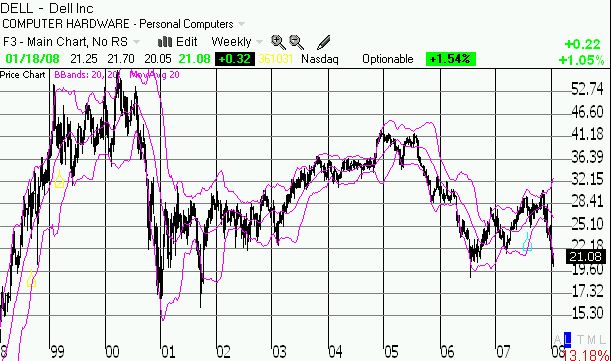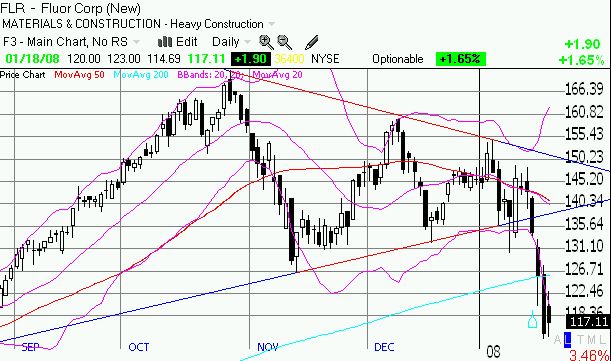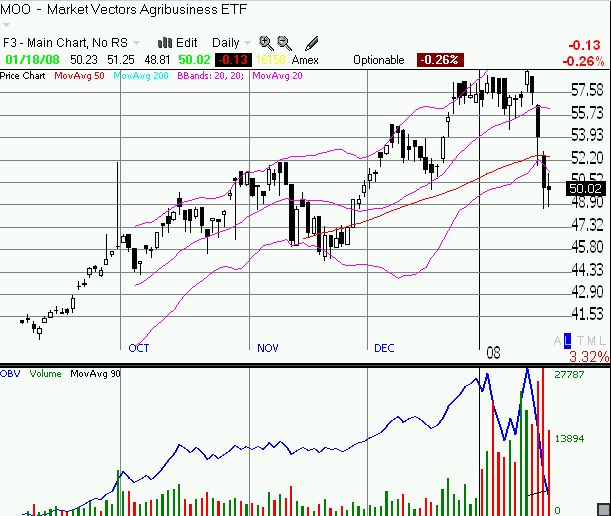You know the market is desperate when pundits stoke hopes with expectations of a surprise Fed rate cut on January's option expiration day to squeeze shorts into submission. Nevermind that the Fed has been cutting and cutting and cutting to no avail. It should be clear to all of us by now that the current rate-cutting campaign is similar to the one earlier this decade where the Fed would cut, the market would rally, and folks would take that opportunity to get out of the market at slightly better prices. Even more concerning is that the market sold off right after the last rate cut. Now, the Federal government is jumping into the act of trying to save us from ourselves. President Bush is proposing tax cuts, again, and the Congress wants spending stimuli. Let us recognize yet again that the business cycle has not been conquered. Let us also recognize yet again that the economic problems we fight now have roots in the economic growth we celebrated yesterday. No one cared to do anything while debt and speculative fever was running wild. But everyone is called to action to plant the seeds for the next explosion in debt. Bush has cut taxes whether times are good or bad. And the Congress always wants to spend more money. Something tells me we have to look elsewhere. Anyway, I will end this piece with some commentary on Ben Bernanke's latest ocmments. But first, I try to play catch-up again on a bunch of wild market action.
In a flash, the S&P 500 and the NASDAQ have wiped out all of 2007's hard fought gains. What looked like amazing resilience through three sell-offs, now looks like a two-ton bear working at next erasing the gains of 2006. If we now finally accept that the housing market matters to the rest of the economy, then let's look there for our future. Most of the major homebuilders are at 4 and 5-year lows, wiping out a majority of the "ill-gotten" gains from the housing bubble. To the extent that the stock market's bounce from 2002 and 2003 was also fueled by debt and not by true wealth-creation, we should eventually see a similar reversal. Just to throw numbers in the air, I will tag the S&P 500 at 1200 before any significant rally ensues. 1200 is where we started 2005. The S&P 500 also oscillated wildly around 1200 for much of that year before finally breaking out in the Fall. Yes, I know this means another 10% drop from current levels. But why not? We have a whole 11 months to drop that much after we have already experienced a 10% drop in less than three weeks.
I talked about big cap tech members Intel (INTC) and Cisco (CSCO) earlier. INTC is now down an incredible 30% already this year. It makes you forget what all the excitement was about when the stock soared to fresh multi-year highs back in October. Check out Thomas Weisel's upgrade to "overweight" at that time, including a target hike to $33: "...based on evidence of above seasonal P.C demand going into 2008. Furthermore, the firm expects demand to remain above expectations throughout 2008 driven by emerging economies. [We] now believe INTC's superior current product line up along its many new product launches expected in 2008 should keep INTC fairly immune from competitive A.S.P pressures." Indeed, during INTC's recent disastrous earnings call the company crooned that the U.S. is "only" 25% of its business. Methinks the mass exodus to global, emerging markets is becoming an increasingly crowded trade as a U.S. recession "exit strategy. "Let's now check in on one of Intel's biggest customers, Dell (DELL).

DELL's recovery essentially peaked three years ago. So, it comes as no surprise that DELL is struggling now. DELL is already working on punching through its 2006 lows, and at these levels it is right back where it was in 2001 and 2002. Perhaps we should have known that Intel could not survive the woes of DELL for too long.
We have often been told that infrastructure stocks would be a great place to hide from the troubles on the domestic scene. The rest of the world continues to build at a furious pace after all. Let's take a look at Fluor Corporation (FLR) which "...through its subsidiaries, provides engineering, procurement, and construction and maintenance (EPCM) services worldwide. It has five segments: Oil & Gas, Industrial & Infrastructure, Government, Global Services, and Power."

This chart shows that FLR has finally resolved the triangle that marked its downward trek since the peak in October. FLR put up a valiant fight, especially at the end. But the downward turn in the 50DMA proved too much. FLR had a violent break of the triangle that took it clean through the 200DMA on high-volume selling. This explosive combination suggests that FLR's long, impressive run is over for now. In other words, we probably should put a lot less faith in the stories about global growth in infrastructure and building as a way to escape from the U.S. Speaking of which, Caterpillar Inc. (CAT) reports earnings this Friday. Last time I wrote about CAT, I scoffed at the company's claims that a recession was coming this year in North America, at least from the technical definition of a recession. I still scoff, ok, maybe just a little less, but I sure do not believe they can continue to buttress results from international sales. Hopefully, CAT has lowered expectations enough such that the stock does not get shellacked again come Friday. CAT has now returned to where it started 2007 and 2006's start is just a few points away.
In another potential sign of things to come, MOO, a well-named, new ETF for agribusiness, kicked off 2008 with tremendous volume. Unfortunately, much of this volume has been down volume. And down it has come 12%. I am not ready to call a top in the market's last darlings like Monsanto (MON), Mosaic (MOS), and Agrium (AGU), but the recent action has all the markings of traders scrambling to seize profits before someone else does. MOO now has a LOT to prove to regain its bullish momentum.

Now let's turn a longing eye overseas for a bit. Last May, I singled out Brazilian telecom Tele Norte Leste Participacoes S.A. (TNE) as a great example of a break-out play. It took a little over another month for new highs, and the stock chopped around for the rest of the year. While the U.S. sold off this year, TNE managed to pop to new multi-year highs on the backs of an upgrade. It has since pulled way back. I am going to keep an active eye on this one again. Maybe it could serve as one legit U.S. exit strategy this year. However, I am disappointed that the large dividend yield is no more.
And let's round this puppy out with the Fed. Consumer prices rose 4.1% in 2007, the highest annual increase since 1990. That was right before a brief recession. During a speech on November 29, 2007, Ben Bernanke reminded us that "The effectiveness of monetary policy depends critically on maintaining the publicís confidence that inflation will be well controlled. We are accordingly monitoring inflation developments closely." Big Ben must have his eyes wide open at this point. Todd Sullivan got my attention by pointing to the end of Big Ben's speech on January 10, 2008. Here, Bernanke once again warns us about inflation:
"Even as the outlook for real activity has weakened, there have been some important developments on the inflation front. Most notably, the same increase in oil prices that may be a negative influence on growth is also lifting overall consumer prices and probably putting some upward pressure on core inflation measures as well. Last year, food prices also increased exceptionally rapidly by recent standards, further boosting overall consumer price inflation. Thus far, inflation expectations appear to have remained reasonably well anchored, and pressures on resource utilization have diminished a bit. However, any tendency of inflation expectations to become unmoored or for the Fedís inflation-fighting credibility to be eroded could greatly complicate the task of sustaining price stability and reduce the central bankís policy flexibility to counter shortfalls in growth in the future. Accordingly, in the months ahead we will be closely monitoring the inflation situation, particularly as regards inflation expectations."
Right after this warning, Bernanke demonstrates yet again that the Fed is willing to push these inflation expectations as far as possible:
"However, in light of recent changes in the outlook for and the risks to growth, additional policy easing may well be necessary. The Committee will, of course, be carefully evaluating incoming information bearing on the economic outlook. Based on that evaluation, and consistent with our dual mandate, we stand ready to take substantive additional action as needed to support growth and to provide adequate insurance against downside risks. Financial and economic conditions can change quickly. Consequently, the Committee must remain exceptionally alert and flexible, prepared to act in a decisive and timely manner and, in particular, to counter any adverse dynamics that might threaten economic or financial stability."
Yet again, we see the recipes for stagflation. Or as I have sarcastically called a "slow-growth, high-price" environment (see July 28, 2006 missive). It seems to me the Fed has few options, yet the market keeps looking for help from the Fed. Bernanke has surely inherited quite a mess from Greenspan's legacy of debt and more debt. And Bernanke has been painted into an even tighter corner - hoping that adding further supports to growing debt will airlift us back to growth.
Be careful out there!